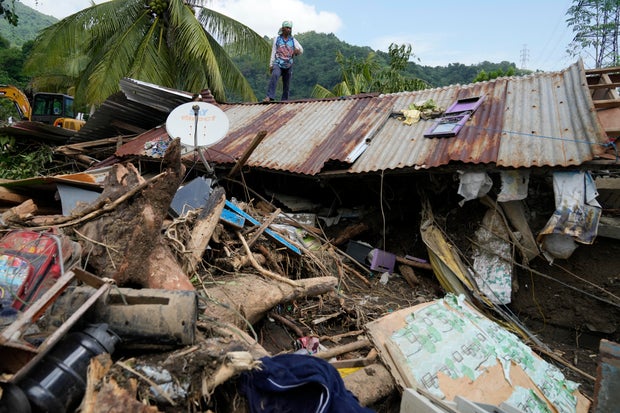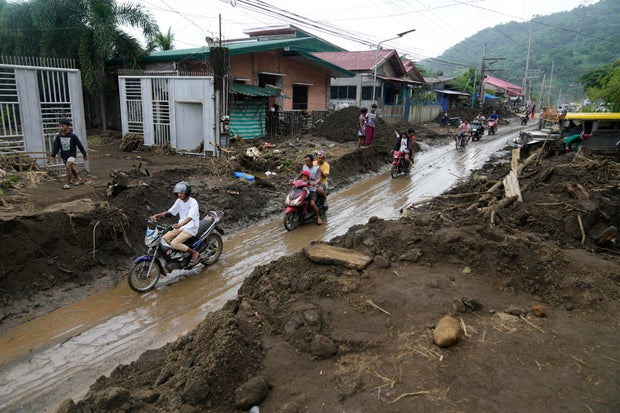CBS News
Deciding between debt relief and bankruptcy? Here are the factors to consider

Getty Images
There’s no question that the current economic landscape is difficult for borrowers. Not only did the interest rates on personal loans, mortgages and other lending products skyrocket throughout 2022 and 2023, but credit card rates did too. Right now, the average credit card rate is above 21%, so cardholders who are unable to pay their card bills in full each month are shelling out a lot of money in interest charges.
And, today’s high-rate environment isn’t the only economic hurdle Americans are facing. Other economic pressures, like persistent inflation continuing to devalue the dollar, are making it even more difficult for people to repay what they owe on their credit cards and high-interest debts.
If you’re one of the many who’s struggling due to growing balances on your credit cards, you may be wondering whether it’s time to pursue debt relief or bankruptcy to get your financial situation under control. But while both avenues can provide some relief from your growing debts, how do you decide which path is right for your unique circumstances? Below, we’ll detail exactly what you should know.
Ready to tackle your credit card debt? Find out what your debt relief options are here.
Factors to consider when deciding between debt relief and bankruptcy
If you’re unsure whether debt relief or bankruptcy makes the most sense for your situation, it may help to consider the following factors:
Your debt-to-income ratio
One metric that’s important to consider as part of your decision is your debt-to-income (DTI) ratio. Your DTI ratio is the percentage of your income each month that goes toward paying your debts. This ratio can give you a good idea of whether your debt levels are sustainable or not, which can help you determine whether bankruptcy or debt relief makes more sense.
To determine your DTI ratio, you simply divide your total recurring monthly debt payments by your gross monthly income. Ratios above 40% are a signal that you likely have unsustainable debt levels that may require more than just a debt management plan or debt consolidation loan. In these cases, debt settlement or bankruptcy could make more sense.
Explore the benefits of debt relief online now.
Cost considerations
Another factor that may sway your decision is weighing the cost of bankruptcy compared to the cost of debt relief programs. While filing for Chapter 7 bankruptcy may seem like the cheapest option, there are court fees, legal fees, credit counseling costs and other expenses to consider. Chapter 13 bankruptcy has even higher costs since it involves a multi-year repayment plan.
But debt relief can be a lot more affordable comparatively. For example, debt relief companies aren’t allowed to charge upfront fees prior to working on your case. Depending on the service they’re providing, these companies typically charge a percentage of the settled amount or a small monthly fee tacked onto your consolidated payment instead.
So those with very little disposable income may find the lower upfront costs of debt relief more manageable than having to pay hefty bankruptcy fees. Of course, DIY debt settlement or management could keep you from paying any program fees, but success rates are typically much lower.
Income and ability to pay
Your income level and ability to make any debt payments are also crucial to evaluating your choices. After all, most debt relief plans require you to make consistent, affordable payments to remain in good standing, so you’ll need to have some disposable income to put toward what you owe.
Bankruptcy, on the other hand, can simply exempt you from having to repay certain types of debts based on your income and asset situation. If your core living expenses for housing, utilities, food and transportation already consume most or all of your income, leaving little to put toward debts, bankruptcy may be prudent.
Asset protection needs
With a Chapter 7 bankruptcy, any non-exempt assets above allowances may be seized and liquidated to repay creditors. While many states offer exemptions for things like home equity, vehicles, household goods and retirement accounts, asset protection needs could make debt relief programs preferable if it’s vital to keep those resources intact.
Credit score impact
Credit score impacts are another major consideration. Any debt relief measure can put a temporary dent in your credit score, but filing for bankruptcy typically leads to the biggest negative impact, at least initially. Other programs like debt management plans and debt settlements typically lead to less severe credit score damage, meaning that they could be the ideal option if you need to preserve your credit profile to qualify for a mortgage or other important financing.
Legal protection
With debt relief programs, your creditors maintain the ability to potentially file lawsuits or garnish wages if you default on payments. This legal risk is something to consider. Bankruptcy provides the strongest legal protection once filed and approved, preventing creditors from continuing collection efforts.
Tax implications
There can also be potential tax implications with debt relief. Forgiven or settled debts may count as taxable income depending on the circumstances. When bankruptcy forgiveness is filed properly, those debts generally aren’t considered taxable income.
The bottom line
Ultimately, there is no one-size-fits-all solution when facing insurmountable debt. The right choice depends on carefully weighing your unique financial circumstances, priorities, eligibility and preferences. And, if you still aren’t sure, consulting with a qualified credit counselor, bankruptcy attorney or financial advisor may provide further guidance and clarity on the best path for regaining control and achieving true freedom from debt.
CBS News
At least 126 dead and missing after landslides, massive flooding in Philippines brought by Tropical Storm Trami

The number of dead and missing in massive flooding and landslides wrought by Tropical Storm Trami in the Philippines has reached nearly 130 and the president said Saturday that many areas remained isolated with people in need of rescue.
Trami blew away from the northwestern Philippines on Friday, leaving at least 85 people dead and 41 others missing in in one of the Southeast Asian archipelago’s deadliest and most destructive storms so far this year, the government’s disaster-response agency said. The death toll was expected to rise as reports come in from previously isolated areas.
Dozens of police, firefighters and other emergency personnel, backed by three backhoes and sniffer dogs, dug up one of the last two missing villagers in the lakeside town of Talisay in Batangas province Saturday.
Aaron Favila / AP
A father, who was waiting for word on his missing 14-year-old daughter, wept as rescuers placed the remains in a black body bag. Distraught, he followed police officers, who carried the body bag down a mud-strewn village alley to a police van when one weeping resident approaching him to express her sympathies.
The man said he was sure it was his daughter, but authorities needed to do checks to confirm the identity of the villager dug up in the mound.
In a nearby basketball gym at the town center, more than a dozen white coffins were laid side by side, bearing the remains of those found in the heaps of mud, boulders and trees that cascaded Thursday afternoon down the steep slope of a wooded ridge in Talisay’s Sampaloc village.
President Ferdinand Marcos, who inspected another hard-hit region southeast of Manila Saturday, said the unusually large volume of rainfall dumped by the storm — including in some areas that saw one to two months’ worth of rainfall in just 24 hours — overwhelmed flood controls in provinces lashed by Trami.
“The water was just too much,” Marcos told reporters.
“We’re not done yet with our rescue work,” he said. “Our problem here, there are still many areas that remained flooded and could not be accessed even big trucks.”
His administration, Marcos said, would plan to start work on a major flood control project that can meet the unprecedented threats posed by climate change.
Aaron Favila / AP
More than 5 million people were in the path of the storm, including nearly half a million who mostly fled to more than 6,300 emergency shelters in several provinces, the government agency said.
In an emergency Cabinet meeting, Marcos raised concerns over reports by government forecasters that the storm — the 11th to hit the Philippines this year — could make a U-turn next week as it is pushed back by high-pressure winds in the South China Sea.
The storm was forecast to batter Vietnam over the weekend if it would not veer off course.
The Philippine government shut down schools and government offices for the third day on Friday to keep millions of people safe on the main northern island of Luzon. Inter-island ferry services were also suspended, stranding thousands.
Weather has cleared in many areas on Saturday, allowing cleanup work in most areas.
Each year, about 20 storms and typhoons batter the Philippines, a Southeast Asian archipelago which lies between the Pacific Ocean and the South China Sea. In 2013, Typhoon Haiyan, one of the strongest recorded tropical cyclones, left more than 7,300 people dead or missing and flattened entire villages.
In 2015, a massive landslide buried dozens of homes near a central Philippine mountain, killing at least 15 people and sending rescuers scrambling to find survivors after some sent text messages pleading for help.
CBS News
Eye Opener: Israel strikes Iran

Watch CBS News
Be the first to know
Get browser notifications for breaking news, live events, and exclusive reporting.
CBS News
AM radio is seeking a lifeline after a century of storied history

Watch CBS News
Be the first to know
Get browser notifications for breaking news, live events, and exclusive reporting.





